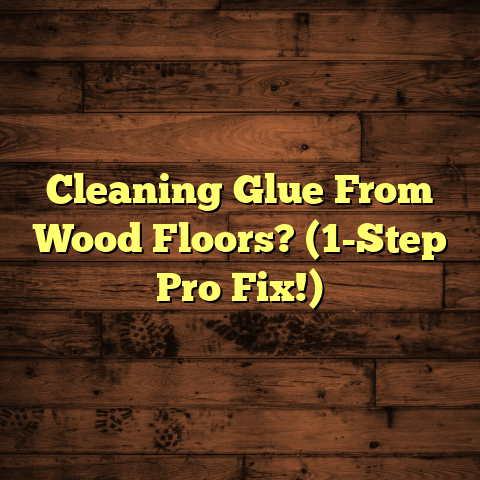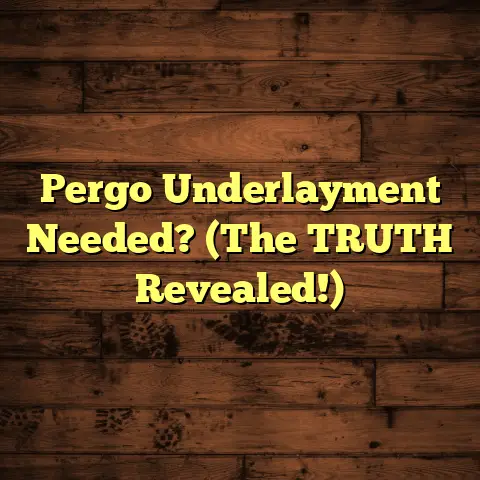Hardwood Floors In Florida? (7 Humidity Risks!)
I love the look and feel of hardwood – it brings a certain warmth and elegance to any home.
But let’s be real: Florida’s climate, with its notorious humidity, can be a real headache for hardwood.
We’re talking potential warping, mold, and a whole lot of other issues you definitely want to avoid.
That’s why I’m writing this for you – to break down the specific humidity risks that hardwood floors face here, and how you can tackle them.
Think of this as your insider’s guide to keeping your hardwood floors looking gorgeous for years to come, even in the face of Florida’s crazy weather.
So, grab a sweet tea, kick back, and let’s dive in!
Section 1: Room-Specific Needs
Okay, so not all rooms are created equal when it comes to humidity and its impact on your hardwood floors.
Let’s walk through some common areas in your home and talk about the specific challenges each one presents.
1. Living Rooms
Your living room is often the heart of your home, a place for relaxation, entertainment, and making memories.
You want it to be comfortable and inviting, and hardwood floors can definitely help create that ambiance.
But here’s the thing: all that lovely furniture and those cozy rugs can actually trap humidity, creating a breeding ground for problems.
I’ve seen cases where humidity caused noticeable warping or buckling, especially around the edges of the room where airflow is limited.
What can you do? Invest in a good quality dehumidifier or ensure your air conditioning system is up to the task of maintaining a consistent humidity level.
I generally recommend keeping it between 30% and 50%.
Also, consider using area rugs that allow for better air circulation underneath.
2. Kitchens
Ah, the kitchen – the culinary command center! But it’s also a moisture magnet.
Between cooking steam, dishwashing splashes, and the occasional spill, your kitchen floor is constantly battling moisture.
Hardwood can be a beautiful choice here, but you’ve got to be smart about it.
I’ve been called to homes where water from a leaky dishwasher has seeped under the hardwood, leading to significant damage and costly repairs.
The key here is protection.
Opt for a durable finish that can withstand the rigors of kitchen life.
Polyurethane finishes are generally a good bet.
Also, be vigilant about cleaning up spills
immediately and using mats in front of
the sink and dishwasher.
3. Bathrooms
Okay, let’s be honest: hardwood in bathrooms is a bit of a controversial topic.
While some homeowners love the look, the reality is that bathrooms are basically humidity chambers.
All that steam from showers and baths can wreak havoc on hardwood if you’re not careful.
I’ve seen bathrooms where mold and mildew have taken hold in the grout lines and even under the flooring itself, creating a real health hazard.
If you’re set on hardwood in your bathroom, you absolutely must prioritize ventilation.
Install a powerful exhaust fan and use it every time you shower or bathe.
Also, consider using a waterproof sealant around the edges of the floor to prevent moisture from seeping in.
Honestly, though, for bathrooms, I often recommend alternatives like tile or luxury vinyl plank (LVP), which are much more moisture-resistant.
4. Bedrooms
Your bedroom should be a sanctuary, a place of rest and relaxation.
Humidity can actually affect your sleep quality, making you feel sticky and uncomfortable.
And guess what? That humidity can also affect your flooring.
While bedrooms typically aren’t as moisture-prone as kitchens or bathrooms, they’re not immune to the effects of humidity.
Air conditioning and heating systems can also play a role, as they can dry out the air or contribute to humidity fluctuations.
Maintaining a consistent temperature and humidity level in your bedroom is key.
Use a humidifier during the dry winter months and a dehumidifier during the humid summer months.
Also, consider using a hygrometer to monitor the humidity levels in your room.
5. Basements
Basements in Florida?
Not super common,
I know, but if you have one, you know they
can be tricky spaces when it comes to humidity.
Basements tend to be naturally damp, as they’re often below ground level and prone to moisture seepage.
Installing hardwood in a basement without proper precautions is basically asking for trouble.
I’ve seen basements where moisture has seeped up through the concrete slab, causing the hardwood to warp and buckle.
If you’re considering hardwood in your basement, you absolutely must install a vapor barrier.
This will help prevent moisture from migrating up into the flooring.
You might also consider installing a subfloor system that allows for air circulation underneath the hardwood.
Honestly, like bathrooms, I often steer clients towards moisture-resistant alternatives for basements.
6. Hallways and Entryways
Hallways and entryways are high-traffic areas that can take a beating.
All that foot traffic can exacerbate wear and tear on your hardwood floors, especially when combined with humidity.
Think about it: people are constantly tracking in dirt, debris, and moisture from outside.
That moisture can then get trapped in the wood, leading to warping and other problems.
Regular cleaning is essential in these areas.
Use a damp mop (not a soaking wet one!) to remove dirt and debris, and be sure to dry the floor thoroughly afterward.
You might also consider using mats at entryways to trap dirt and moisture before they get tracked onto your hardwood.
7. Outdoor Spaces (if applicable)
Okay, so this is a bit of a niche, but I’ve seen a growing trend of homeowners using hardwood in covered patios or outdoor living areas.
While it can create a beautiful and inviting space, it also comes with some serious challenges.
Even under a covered patio, your hardwood is still exposed to the elements, including Florida’s relentless humidity.
The fluctuating temperatures and humidity levels can cause the wood to expand and contract, leading to warping, cracking, and other problems.
If you’re going to use hardwood in an outdoor space, you need to choose a species that is specifically designed for outdoor use.
Ipe, teak, and other hardwoods are naturally resistant to moisture and decay.
You’ll also need to apply a protective finish regularly to help protect the wood from the elements.
Section 2: The 7 Humidity Risks of Hardwood Floors in Florida
Alright, now let’s get down to the nitty-gritty.
Here are the 7 biggest humidity risks
that hardwood floors face here in Florida:
1. Risk of Warping
Warping is probably the most common problem I see with hardwood floors in Florida.
High humidity causes the wood fibers to absorb moisture and swell.
When the wood swells unevenly, it can cause the boards to warp, creating an uneven and unsightly surface.
I’ve seen floors where the edges of the boards have curled up, creating a tripping hazard.
Visual examples?
Imagine a perfectly flat floor suddenly developing waves or humps.
That’s warping in action.
It not only looks bad but can also affect the stability of your furniture and make it difficult to walk on.
2. Mold and Mildew Growth
Mold and mildew thrive in humid environments, and hardwood floors can be a perfect breeding ground.
These fungi can grow on the surface of the wood, causing discoloration and staining.
But the real danger lies beneath the surface, where mold and mildew can eat away at the wood fibers, weakening the floor and creating a health hazard.
I’ve been in homes where the musty smell of mold was overwhelming, and the hardwood floors were literally rotting from the inside out.
This is not just an aesthetic issue; it’s a health concern.
Mold can trigger allergies, asthma, and other respiratory problems.
3. Buckling
Buckling is a more extreme form of warping.
It happens when the wood expands so much
that it literally lifts off the subfloor.
I’ve seen floors where the boards have popped up several inches, creating a major safety hazard.
Why does this happen?
Well, when hardwood absorbs moisture,
it expands.
If there’s not enough room
for the wood to expand, it will start to
push against adjacent boards.
Eventually, the pressure becomes so great that the floor buckles.
This is more common in areas with poor ventilation or where water has accumulated under the floor.
4. Joint Separation
Remember those lovely, tight seams between your hardwood planks?
Well, humidity can mess with those, too.
Excess moisture causes the wood to swell, pushing against adjacent boards.
When the humidity drops, the wood shrinks, leaving gaps between the boards.
Over time, this repeated swelling and shrinking can cause the joints to separate, creating unsightly gaps and making the floor feel uneven.
The long-term consequences?
These gaps can collect dirt and debris, making the floor harder to clean.
They can also allow moisture to seep down into the subfloor, leading to further damage.
5. Finish Deterioration
The finish on your hardwood floors is what protects them from wear and tear.
But humidity can weaken the finish, making it more susceptible to scratches, dents, and other damage.
I’ve seen floors where the finish has peeled or cracked, leaving the wood exposed and vulnerable.
What types of finishes are more resistant?
Polyurethane finishes are generally more durable and water-resistant than other types of finishes.
However, even polyurethane finishes can be damaged by prolonged exposure to humidity.
6. Increased Maintenance Needs
All these humidity-related problems add up to one thing: more maintenance.
You’ll need to clean your floors more frequently to remove dirt and debris.
You’ll also need to be more vigilant about monitoring humidity levels and taking steps to control them.
What are the costs?
Well, you might need to invest in a dehumidifier or a better air conditioning system.
You might also need to hire a professional to repair or refinish your floors more often.
And let’s not forget the time you’ll spend cleaning and maintaining your floors.
7. Reduced Lifespan
Ultimately, all these factors contribute to a decreased lifespan for your hardwood floors.
In a dry climate, a well-maintained hardwood floor can last for decades.
But in Florida’s humid climate, you might be lucky to get 10-15 years out of your hardwood floors if you’re not careful.
Expert opinions?
According to the National Wood Flooring Association (NWFA), proper acclimation and humidity control are essential for extending the life of hardwood floors.
They recommend maintaining a consistent humidity level between 30% and 50% to prevent damage.
Conclusion
So, there you have it – the 7 biggest humidity risks that hardwood floors face here in Florida.
I know it sounds like a lot, but don’t let it scare you away from enjoying the beauty and warmth of hardwood floors in your home.
The key is to be aware of the risks and take proactive steps to mitigate them.
Remember to consider your specific room needs and the associated humidity risks as you plan for hardwood flooring installation or maintenance.
Invest in a good quality dehumidifier, maintain a consistent humidity level, and clean your floors regularly.
With a little bit of effort, you can keep your hardwood floors looking gorgeous for years to come, even in the face of Florida’s challenging climate.
And hey, if you ever have any questions or need some expert advice, don’t hesitate to reach out to a local flooring contractor like myself.
We’re here to help you make the best decisions for your home and your budget.





